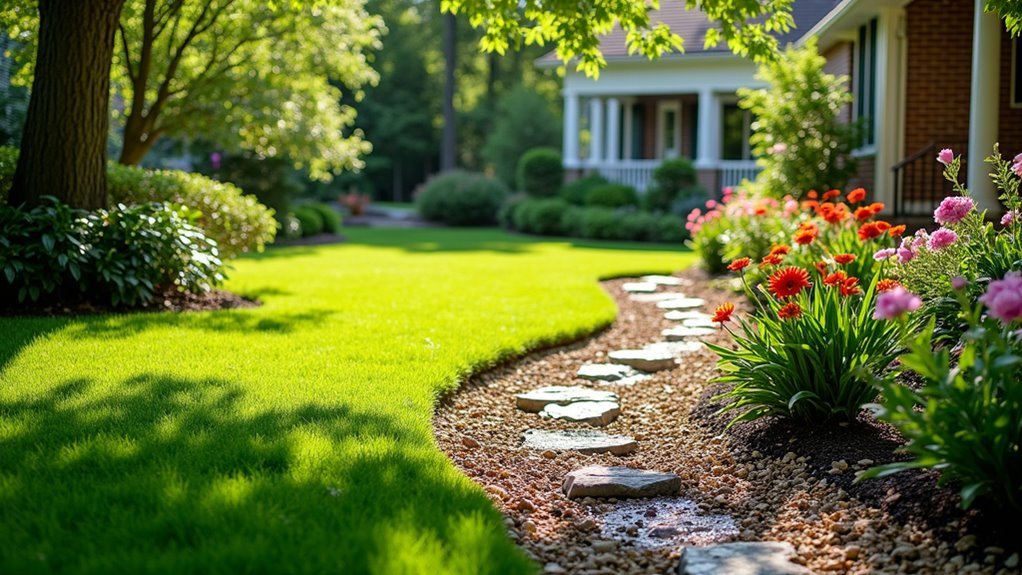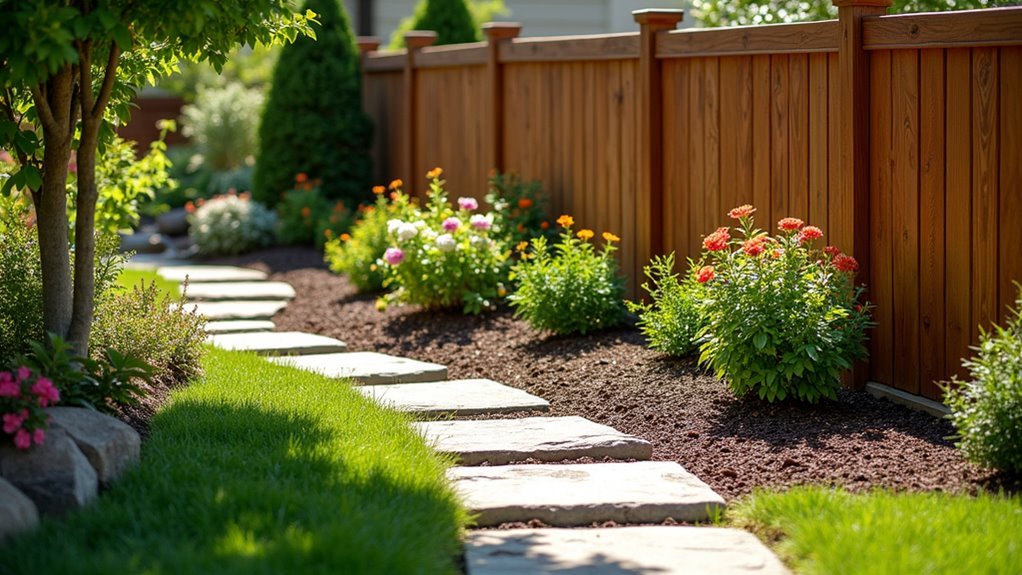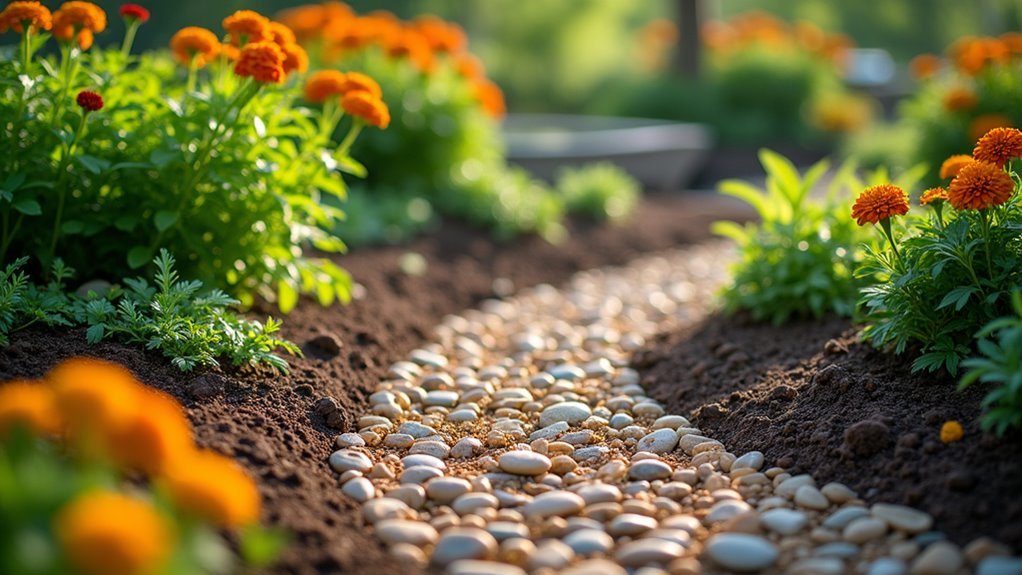You can prevent earwigs by eliminating their preferred environments through five key strategies. Remove moisture sources by fixing leaks and improving drainage around your foundation. Eliminate hiding spots by trimming vegetation and maintaining proper spacing between plants and your home’s exterior. Create physical barriers using door sweeps, weather stripping, and copper tape around entry points. Manage mulch by keeping it away from foundations and replacing organic materials with gravel. Establish regular cleanup routines to remove debris and standing water that attract these pests—these foundational steps will transform your property into an inhospitable environment for earwigs.
Remove Moisture Sources and Improve Drainage

Since earwigs thrive in moist environments, you’ll need to eliminate excess water sources around your property to make it less appealing to these pests.
Start by regularly inspecting and repairing leaking pipes, faucets, and irrigation systems that create excess moisture. Improve drainage by ensuring downspouts direct water away from your foundation, reducing standing water and damp areas where earwigs congregate.
Fix water leaks and redirect drainage away from your home’s foundation to eliminate moist areas where earwigs gather and breed.
Keep gutters clean and unclogged to prevent water accumulation that creates ideal earwig habitats. Use a dehumidifier in damp basements to lower humidity levels.
Water outdoor plants in the morning, allowing soil time to dry and minimizing moisture retention. These effective pest control solutions target the root cause of earwig infestations by eliminating the damp conditions they require for survival.
Eliminate Hiding Spots Through Strategic Plant Placement
Because earwigs excel at finding cozy hiding spots in dense vegetation, you’ll want to strategically arrange your landscaping to eliminate these shelters.
Trim back vegetation regularly, focusing on overgrown bushes and ground cover that create dark, moist hideaways near your home’s perimeter. This creates a clear defensive border that’s less appealing to earwigs.
Avoid planting flowers and shrubs directly against your foundation, as this provides convenient access routes for earwigs seeking shelter.
Instead, maintain adequate spacing between plants and your home’s exterior walls.
When using mulch, apply it sparingly and keep it several inches away from the foundation.
Dense mulch retains moisture and creates ideal earwig habitat.
Strategic plant placement combined with proper spacing will keep earwigs from establishing colonies near your home.
Create Physical Barriers Around Your Property

While strategic plant placement reduces earwig habitat, physical barriers provide your most reliable defense against these persistent pests entering your home.
Start by installing door sweeps and weather stripping around entry points to seal gaps under doors and windows. Add mesh screens to windows and vents for ventilation without compromising protection.
To create physical barriers that prevent earwigs effectively, establish a clear perimeter around your foundation. Trim vegetation back from your home’s exterior and remove debris piles where earwigs hide.
Apply copper tape or diatomaceous earth around your foundation as additional deterrents.
Regular maintenance guarantees long-term success. Inspect your foundation monthly, sealing any new cracks or crevices immediately.
These combined barrier methods create multiple defense layers, considerably reducing earwig infiltration into your living spaces.
Maintain Proper Mulch and Ground Cover Management
Beyond establishing protective barriers, you’ll need to address the ground materials directly surrounding your home. Proper mulch application and ground cover materials management considerably reduces earwig attraction by eliminating their preferred habitats.
Managing ground materials around your foundation effectively eliminates the moist, organic environments that earwigs actively seek for shelter and breeding.
Here’s how to optimize your ground cover strategy:
- Limit mulch thickness – Keep organic mulch no thicker than 2-3 inches and maintain distance from your foundation to prevent moisture buildup that earwigs crave.
- Choose alternative materials – Replace organic mulch with gravel or stone around your home’s perimeter to eliminate decomposing matter that attracts earwigs.
- Maintain regularly – Inspect ground cover materials frequently, removing accumulated debris and renewing decomposed organic matter to prevent creating favorable earwig environments.
Keep all ground cover well-aerated and clutter-free for maximum effectiveness.
Establish Regular Garden Cleanup and Debris Removal Practices

Since earwigs thrive in cluttered environments with abundant hiding spots, establishing consistent garden cleanup routines becomes your most effective long-term prevention strategy. You’ll need to remove debris piles regularly, including dead plants and fallen leaves that create perfect earwig shelters around your home’s exterior.
| Cleanup Task | Frequency |
|---|---|
| Remove dead plants and leaves | Weekly |
| Clear unused garden materials | Bi-weekly |
| Organize tools and containers | Monthly |
| Check for standing water | Weekly |
Dispose of unused garden materials promptly and clear away clutter like tools and containers that create nesting opportunities. Don’t forget to eliminate standing water, as excess moisture attracts these pests. By maintaining organized outdoor storage areas free from debris, you’ll greatly reduce your risk of earwig infestation and keep earwigs in your garden under control.
Frequently Asked Questions
What Can I Plant to Keep Earwigs Away?
You can plant marigolds, basil, rosemary, and mint to repel earwigs with their strong scents. Garlic, onions, nasturtiums, and zinnias also work well. Choose plants with rough textures like lamb’s ear for added protection.
What Is the Best Earwig Deterrent?
You’ll find diatomaceous earth works as the most effective earwig deterrent. It mechanically dehydrates them on contact, creating a barrier they can’t cross around your garden beds and home perimeter.
What Do Earwigs Hate the Most?
Earwigs hate dry conditions most since they need moisture to survive. They also despise bright, sunny areas and avoid abrasive textures like diatomaceous earth that damage their soft bodies.
How Do I Permanently Get Rid of Earwigs?
Seal all entry points around doors, windows, and foundations. Eliminate moisture by fixing leaks and improving drainage. Remove debris piles and trim vegetation near your home’s foundation to permanently eliminate earwig infestations.
In Summary
You’ll create an unwelcoming environment for earwigs by implementing these five landscape strategies. Focus on eliminating moisture, removing hiding spots, and maintaining clean garden spaces. Don’t forget to install physical barriers and manage your mulch properly. These combined efforts will greatly reduce earwig populations around your property. Stay consistent with your maintenance routine, and you’ll notice fewer of these pests invading your outdoor spaces and potentially your home.





Leave a Reply